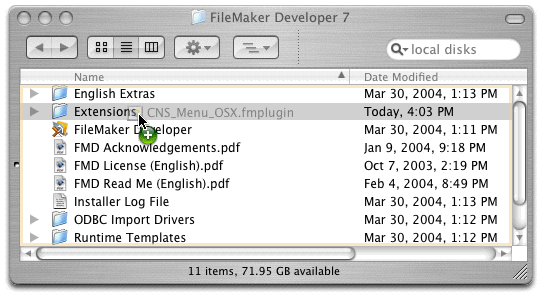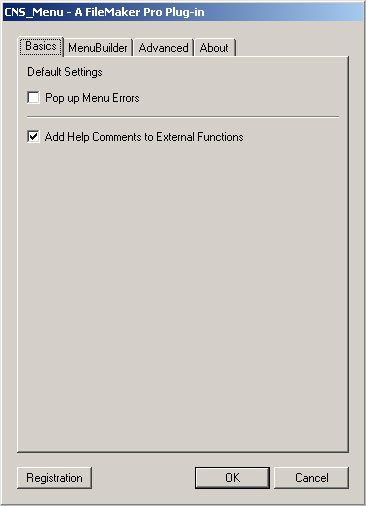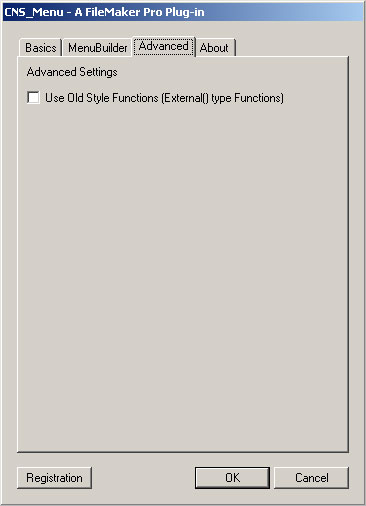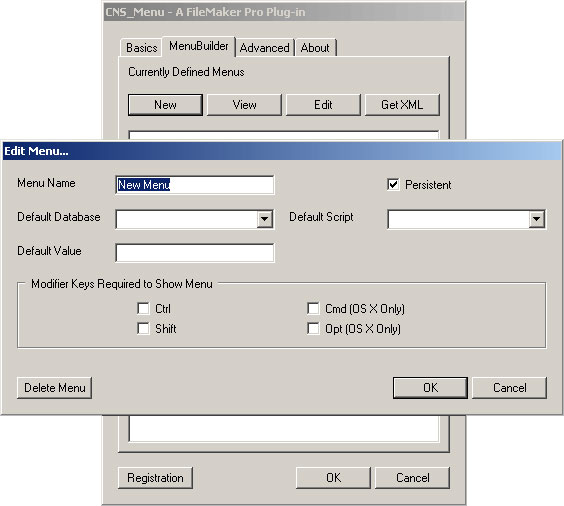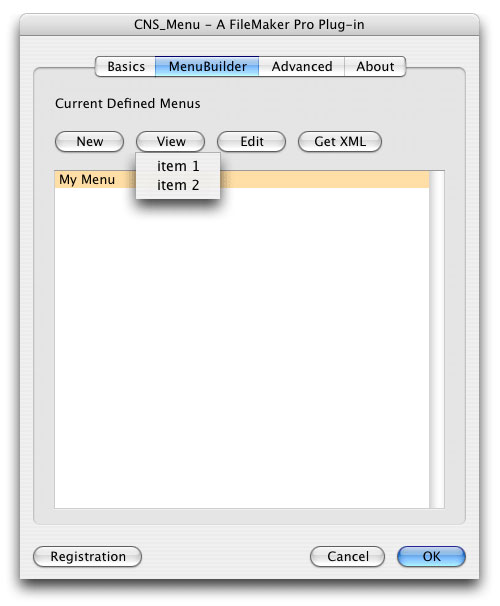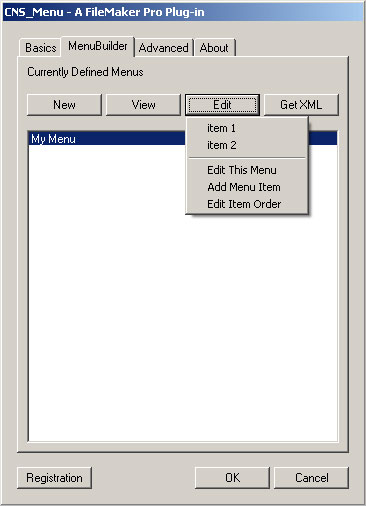
CNS Menu Plug-in
CNS Menu allows you to place hierarchal menus anywhere on a FileMaker layout. When a menu item is chosen, the script of your choice in the database of your choice is performed.
|
Features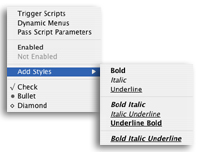
- Dynamically create popup menus
- Easily convert return delimited items such as value lists, layout names, and more, into QuickMenus.
- Add style to menu items such as bold, underline, italic, and any combination of those.
- Add bullets to your menu items including check, circular bullet, and diamond.
- Pass script parameters through menus to your scripts.
- Enable and disable menu items on the fly.
- Update menu items dynamically.
- Precisely display menus using left, top, align, and minWidth.
- Use the built in MenuBuilder to quickly build XML menus - without having to learn XML.
- Use modifier keys to display alternate menu items including Shift, Control, Command, Option, and Alt.
- Get mouse coordinates with the CNSMenu_GetMouseCoordinates function.
- Get the mouse button number clicked with the CNSMenu_GetMouseButton function.
- Simple data entry by allowing a user to find items quickly through sub menus.
- Display a user friendly menu item, but pass a value such as a Customer ID to your scripts.
- Load an XML menu from your hard drive.
|

Documentation Overview
The following is a description of each section of the CNS Menu documentation.
Overview of Chapters
The following is an overview of the chapters in the CNS Menu documentation.
Chapter 1: Introduction
Chapter 2: Installation, Configuration, and Registration
Chapter 3: CNS Menu Example Database
CNS Menu ships with the "CNS Menu.fp7" example database which includes 15 examples demonstrating ways to use and understand the CNS Menu plug-in. The database is fully unlocked so you can explore every detail. We have also included the documentation for each example inline, so you can both examine the example and see its explanation all from one layout.
Chapter 4: MenuBuilder
Creating menus is now easier than ever! MenuBuilder allows you to create and edit menus without having to edit XML.
Chapter 5: Credits & Contact Information
Overview of Appendixes
The following is an overview of the appendixes in the CNS Menu documentation.
Appendix A: Functions
Contains a list of all available functions and a complete description of each.
Appendix B: XML Definitions
Contains a list of all available XML tags found in CNS Menu and a complete description of each.
Appendix C: Function Error Responses
Chapter 1
Introduction
Introduction
CNS Menu allows you to place hierarchal menus anywhere on a FileMaker® Pro layout. When a menu item is chosen, the script of your choice in the database of your choice is performed. Menus can have any number of sub menus and can be displayed with a variety of styles and bullet marks. Creating menus with CNS Menu is as easy as handing the plug-in a return-delimited list of menu items to display. Your menu items can have a display name, and a value that can be used in your scripts, so the end user can see useful information such as a customer name while the value can be a Customer ID number.
CNS Menu ships with the "CNS Menu.fp7" example database which includes 15 examples demonstrating ways to use and understand the CNS Menu plug-in. The database is fully unlocked so you can explore every detail. We have also included the documentation for each example inline, so you can both examine the example and see its explanation all from one layout. Examples include, QuickMenu, Menu Placement, MenuBuilder, Value List to QuickMenu, Hidden Items, Menu Decoration, Mouse Grabber, Right Click, Data Entry, Layout Navigation, Update Menu Item, Bookmark Example, External XML Menu, and RSS Menu.
CNS Menu has many advantages over its predecessor, SCRIPTit. This rendition includes MenuBuilder in the configuration dialog which allows you to quickly build new menus without having to know XML. You can then simply use menus built in MenuBuilder in your database, or copy the XML which is generated for you. CNS Menu also includes a brand new way to create menus called "QuickMenus". A QuickMenu takes a return-seperated list of items and creates a menu for you without having to know or use any XML.

Chapter 2
Installation, Configuration, and Registration
Installation
Installing CNS Menu is very easy. If FileMaker® Pro is open, then close it. Next, locate the folder on your hard drive that contains your FileMaker Pro application. For Macintosh, this is usually in the Applications folder; while on Windows, it is usually in the Program Files folder. Next to the FileMaker Pro application, you should see a folder named Extensions. Copy the plug-in file into this folder to install it into FileMaker Pro.
Figure 2.1 Installation
After installing the plug-in as described above, you can open FileMaker Pro again and the plug-in should automatically be active. You an then open the "CNS Menu.fp7" database to begin exploring CNS Menu.
Configuration
Basics
Once the Configuration Dialog is open, click the Basics tab where you can set the following values. The Pop up Menu Errors check box allows you to enable or disable Popup dialogs that display menu errors. See "CNSMenu_PopupMenuErrors" in Appendix A for more information about using the Pop up Menu Errors option. The Automatically set empty values to the menu item name check box allows you to tell the plug-in whether or not to use the menu item name as the value of the menu item if a value is not defined. The Add Help Comments to External Functions check box allows you to turn off the help comments that are inserted into your calculation when you double-click a function from the list of external functions.
Figure 2.2 Basics Tab
MenuBuilder
The MenuBuilder Tab allows you to create and edit menus. See Chapter 4 for more information about creating and editing menus here.
Figure 2.3 Menus Tab
Advanced
The Advanced Tab allows you to define whether the New style functions, the Old style functions, or both are enabled. The New style functions look like CNSMenu_ShowMenu("some menu"), while the Old style functions look like External("Scrp-ShowMenu", "some menu") which is useful if you had a database created that worked with the SCRIPTit plug-in. In order for the old syle functions to change, you must uncheck and recheck CNS Menu in FileMaker Pro's Application Preferences dialog, or restart FileMaker Pro.
Figure 2.4 Advanced Tab
About
The About Tab reports which version of CNS Menu you are using, who the plug-in is registered to, and how many seats the plug-in is registered for. You can also use the "CNSMenu_ShowConfigDialog" function to bring up the Configuration Dialog. To make sure that you have the most recent version of CNS Menu, please visit our website (http://cnsmenu.cnsplug-ins.com/)
Figure 2.5 About Tab
Registration
When you decide to purchase CNS Menu, you can obtain a license from our secure online purchase form at https://secure.comm-unity.net/purchase.htm. Once you have purchased a license to use CNS Menu, we will send you a license key to register your copy of the plug-in. To do that, open any of the example databases and press the "Register CNS Menu" button and enter your license key information.
Chapter 3
CNS Menu Example Database
CNS Menu ships with the "CNS Menu.fp7" example database which includes 15 examples demonstrating ways to use and understand the CNS Menu plug-in. The database is fully unlocked so you can explore every detail. We have also included the documentation for each example inline, so you can both examine the example and see its explanation all from one layout.
Following is a list and description of each example included. For greater detail, read the documentation for each example in the "CNS Menu.fp7" database.
Creating menus is now easier than ever! MenuBuilder allows you to create and edit menus without having to edit XML.
First, open FileMaker® Pro and then open up the CNS Menu configuration dialog. To do this on Windows, go to the "Edit" menu, and select "Preferences". This should bring up the "Preferences" dialog. Next, click on the "Plug-ins" tab, double-click the CNS Menu plug-in, and select the "Menu Builder" tab. On Mac OS X, go to the "FileMaker Pro" menu, and select "Preferences". This should bring up the "Preferences" dialog. Next, click on the "Plug-ins" tab, double-click the CNS Menu plug-in, and select the "MenuBuilder" tab. This list shows all menus that have been created, either through MenuBuilder or through an external function.
Figure 4.1 MenuBuilder
To create a new menu, click the "New" button. The "Menu Name" field is where you specify the name of the menu. The "Persistent" check box, when checked, saves the menu even after FileMaker Pro is closed. It does this by saving an XML file in the "Extensions" folder where the plug-in is installed. By default, a menu created in MenuBuilder will be persistent. Alternatively, a menu created through an external function will not be persistant by default. The "Default Database" field is the default database for all the menu items contained in this menu. If you do not specify a database when defining a menu item, this default database will be used. The "Default Script" field defines the default script for all the menu items contained in the menu. If you do not specify a script when defining a menu item, this default script will be used. The "Default Value" field defines the default value for all the menu items contained in this menu. If you do not specify a value when defining a menu item, this default value will be used. The Modifer Keys check boxes allow you to define keys that are required in order to show the menu. If the specified modifier keys are not held down when you call CNSMenu_ShowMenu, then the menu will not be shown. Instead, the default script will be called in the default database. If you are making a cross-platform solution, you will only want to use the "Ctrl" and "Shift" modifier keys because windows does not have the "Cmd" and "Opt" keys. Click the "Ok" button when you are finished editing to save your changes.
Figure 4.2 MenuBuilder - New Menu
Once you have created a menu, you can select it from the list and click the "View" button to show the menu. This allows you to see what the actual menu will look like without having to go back to your layout.
Figure 4.3 MenuBuilder - View
To edit your menu, select it from the list and click the "Edit" button. This opens your menu in an editing mode where you can change all aspects of the menu. At the bottom of the menu are three editing menu items, including "Edit This Menu", "Add Menu Item", and "Edit Item Order".
The "Edit This Menu" choice allows you to change the settings for the current menu. These are the same settings as described above when creating a new menu. This window also allows you to delete your menu by clicking the "Delete Menu" button.
The "Add Menu Item" choice allows you to add menu items, submenus, separators, and insert menus.
The "Edit Item Order" choice allows you to rearrange the order of your items on the current menu.
Figure 4.4 MenuBuilder - Edit
To edit a menu item, click on it to open the editing window for that item. The "Item Name" field is where you specify the name of the menu item. This name will appear on the menu. The "Enabled" check box defines whether or not the menu item is enabled. If the menu item is disabled, it will appear greyed and the user will not be able to select it. The "Database" field defines the database that contains the script for this menu item. If this is not defined, the default database from the parent submenu or menu will be used. The "Script" field defines the script to be called when the user selects this menu item. If this is not defined, the default script from the parent submenu or menu will be used. The "Value" field defines a user-supplied value for this menu item. This value can be retrieved using the CNSMenu_GetMenuValue function. The "Group ID" field defines a user-supplied group identifier for this menu item. This is used in conjunction with the modifierkeys attribute to selectively show alternative menu items depending on which modifer keys are held down. The "Modifer Keys" check boxes allow you to define the modifier keys that are required in order to show this menu item. If the specified modifier keys are not held down when this menu is shown, this menu item will not be shown. If you are making a cross-platform solution, you will only want to use the "ctrl" and "shift" modifier keys because windows does not have the "opt" and "cmd" keys. The "Mark" radio buttons define the mark that is displayed to the left of the menu item. Click the "Ok" button when you are finished editing to save your changes.
Figure 4.5 MenuBuilder - Edit Menu
Lastly, select a menu from the list, and click the "Get XML" button. This window allows you to view the XML for each menu. From here you can copy and paste the XML to wherever you need it.
Figure 4.6 MenuBuilder - XML
Programming and documentation by Jake Traynham
Concept, web design, and example databases by Jesse Traynham
Documentation, product testing, and example databases by Daniel Sims
Email: cnsmenu@cnsplug-ins.com
CNS Menu Website: http://cnsmenu.cnsplug-ins.com/
Main Website: http://www.cnsplug-ins.com/
Phone: 817-238-1688
Fax: 817-238-9688
You can write us at:
Comm-Unity Networking Systems
6560 Lake Worth Blvd. Ste. 300
Fort Worth, Texas 76135


